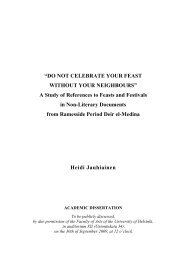BIA
bia51
bia51
You also want an ePaper? Increase the reach of your titles
YUMPU automatically turns print PDFs into web optimized ePapers that Google loves.
MARS 2015<br />
dynasty of Abydos,” a small town near the<br />
Upper Egyptian city of Suhâg. His tomb was<br />
accidently found last year during excavation<br />
work by an American-Egyptian archaeological<br />
mission from the Penn Museum in South<br />
Abydos. Although the tomb was robbed in<br />
antiquity, it still bears witness to the political<br />
and social history of Egypt’s Second<br />
Intermediate Period and the lost Abydos<br />
Dynasty.<br />
According to tomb discoverer Josef WEGNER,<br />
an associate curator at the Penn Museum, the<br />
discovery of the tomb confirms the existence of<br />
an independent “Abydos Dynasty.” According to<br />
Danish Egyptologist Kim RYHOLT, this dynasty<br />
was contemporary with both the Kingdom of<br />
Thebes and the Hyksos Kingdom in the north<br />
of Egypt.<br />
The discovery also identifies the location of<br />
the dynasty’s royal necropolis in South Abydos,<br />
in an area called “Anubis-Mountain” in ancient<br />
times. Royal burials were placed here adjacent<br />
to the tombs of earlier Middle Kingdom<br />
pharaohs.<br />
“Senebkay’s name may have appeared in a<br />
broken section of the famous Turin King List,”<br />
said WEGNER. The Turin King List is a papyrus<br />
document dating to the reign of Ramses II and<br />
now at the Turin Museum in Italy. WEGNER<br />
explained that two kings with the throne name<br />
Woseribre, the first name of the pharaoh, are<br />
recorded at the head of a group of more than<br />
a dozen kings, most of whose names are<br />
entirely lost.<br />
The remains of the king were unearthed<br />
amidst the debris of his fragmentary coffin,<br />
funerary mask and canopic chests made of<br />
cedar wood that had been reused from the<br />
nearby tomb of Sobekhotep I and still bore the<br />
name of the earlier king and were covered in<br />
gilding.<br />
“Using objects from the nearby Sobekhotep<br />
tomb shows the limited resources and isolated<br />
economic situation of the Abydos Kingdom,<br />
which lay in the southern part of Middle Egypt<br />
between the two larger Kingdoms of Thebes<br />
and the Hyksos in northern Egypt,” said WEGNER.<br />
He said that the pharaohs of the Abydos<br />
Dynasty were largely forgotten by history and<br />
their royal necropolis had been unknown until<br />
the discovery of Senebkay’s tomb.<br />
Ankle and skull of Senebkay<br />
Research and forensic analysis was carried<br />
out on the king’s skeleton after the discovery,<br />
revealing details of his life, the Abydos Dynasty<br />
and the Second Intermediate Period of which<br />
he was a part. In a report published on the<br />
Penn Museum website, WEGNER wrote that<br />
analysis carried out by Maria ROSADO and Jane<br />
HILL of Rowan University indicates that<br />
Senebkay lived during the latter part of Egypt’s<br />
Second Intermediate Period and died between<br />
the age of 35 and 40 years during a vicious<br />
assault by multiple assailants.<br />
“The king’s skeleton has 18 wounds<br />
penetrating to the bone, as well as vertical<br />
major cuts in his feet, ankles, knees, hands<br />
and lower back,” WEGNER said. Three major<br />
blows were found on Senebkay’s skull, the<br />
result of the use of battle-axes. “This evidence<br />
indicates the king died violently during a<br />
military confrontation, or in an ambush,” he<br />
added.<br />
The angle and direction of the wounds<br />
suggest that Senebkay was in a higher position<br />
than his assailants when they attacked him with<br />
axes. “He was possibly mounted on horseback,<br />
and blows to his back and legs caused him to<br />
fall to the ground where he was brutally struck<br />
on his head until death,” said WEGNER, who<br />
added that the shape of the pharaoh’s pelvis<br />
indicated that he was a skilled horse rider.<br />
“Another king’s body discovered this year in<br />
a tomb close to that of Senebkay also shows<br />
evidence of horse riding, suggesting that these<br />
Second Intermediate Period kings buried at<br />
Abydos were accomplished horsemen,” WEGNER<br />
wrote. The use of horses in battle was not<br />
common until the Bronze Age.<br />
Yûsuf Khalîfa, head of the Ancient Egyptian<br />
Antiquities Department at the Ministry of<br />
Culture, told the Weekly that it was not clear if<br />
<strong>BIA</strong> LI — Janvier/Juin 2015 70



